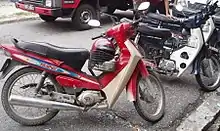Snatch theft
Snatch theft is a criminal act, common in Southeast Asia, South America, and Southern Europe, of forcefully stealing a pedestrian's personal property by employing rob-and-run tactics.


Description
It is typical for two thieves to work together and ride a motorcycle, moped, or other type of motorbike to make theft and escape easier. One person steers the vehicle while another, the snatcher, does the act of theft itself.[1] However, some snatch thieves work alone[2] or do not use a vehicle to escape.
Argentina
In Argentina this form of robbery increased by 118% between the years 2008 and 2009,[3] possibly because motorbikes have become a lot cheaper and more accessible to the public. In that country, the perpetrators are called motochorros, a neologism from the words moto (motorcycle) and chorro (a vulgar term for "thief").
Malaysia
A growing problem in Malaysia, some instances of snatch theft have caused fatalities, when the person holding onto the handbag has been dragged by the motorbike, or through subsequent acts of violence. This, combined with the apparent lack of police control over crime, has prompted outrage among its citizens enough to take justice into their own hands in apprehending thieves.
Philippines
In the Philippines, a crime including snatch theft that is committed by two persons or more is called "riding in tandem".[4] The term normally applies to two men riding on a motorcycle in tandem.[4] The phrase "riding in tandem" was suggested as a 2014 "Filipino word of the year".[5]
In Mandaluyong City, an ordinance was passed to counter the crimes committed by persons riding in tandem.[6] For easy identification, Dagupan City, Cotabato City, Dumaguete City and Batac, Ilocos Norte have local laws prohibiting motorcycle riders from wearing helmets.[7] In Quezon City, the local police considered a measure that would require riders of motorcycles to wear vests displaying the license plate numbers of their vehicles.[8]
Due to the rise of riding in tandem crimes, Philippine Senator Tito Sotto proposed a bill that would allow motorcycles to be ridden only by one person, with some exceptions.[9] According to the Philippine National Police, there were more than 3,000 cases involving crimes related to "riding in tandem".[10]
References
- The Borneo Post Jan 9, 2016 Comatose snatch theft victim regains consciousness "she fell victim to a snatcher"
- Tribune India Aug 30 2015 12:41AM Woman shows exemplary courage, pulls down snatcher from his motorbike
- "En un año, se duplicaron en la Ciudad las denuncias contra motochorros". www.clarin.com.
- Tan, Michael (October 24, 2014). "'Riding in tandem'". Philippine Daily Inquirer. Retrieved August 5, 2014.
- Viray, Patricia Lourdes (September 25, 2014). "'Selfie', 'imba', 'peg' nominated 'word of the year'". The Philippine Star. Retrieved August 5, 2014.
- Sabillo, Kristine Angeli (September 4, 2014). "Mandaluyong channels Colombia law vs men riding-in-tandem". Philippine Daily Inquirer. Retrieved August 5, 2016.
- Medina, Troy (August 20, 2014). "By the numbers: Riding in tandem". BusinessWorld. Retrieved August 5, 2016.
- Cayabyab, Marc Jayson (April 18, 2013). "QC motorbike riders to get vests printed with plate numbers". GMA News. Retrieved August 5, 2016.
- Reyes, Ernie (August 12, 2014). "RIDING IN TANDEM : Sotto wants ban on back-riders". InterAksyon. Retrieved August 5, 2016.
- Sevidal, Edwin (January 28, 2014). "PNP: 'Riding-in-tandem' cases reached 3,000 in 2013". ABS-CBN News. Retrieved August 5, 2016.